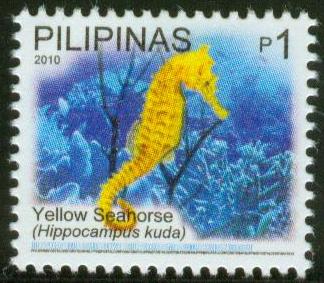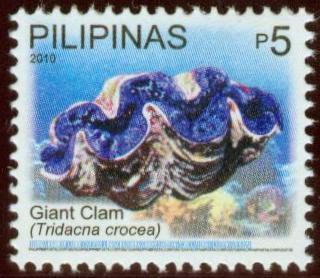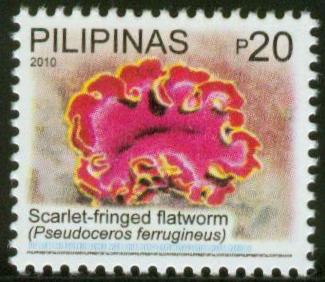2010, June 15. Philippine Marine Biodiversity - Definitives
Litho Offset. Amstar Company, Inc. Perf. 13.5
Singles, Sheets of 100 (10 x 10)


1p - Yellow Seahorse - Singles (2,800,000)
5p - Giant Clam - Singles (2,500,000)
20p - Scarlet-Fringed Flatworm - Singles (900,000)
Designers: Lino B. Jamisola (1p); Mary Anne C. Cruz (5p); Lawrence Cunanan (20p)
Graphic Artist: Earvin L. Ayes
Design Coordinators: Victorino Z. Serevo; Elenita D.L. San Diego
Source: Coral Reef Animals of the Indo-Pacific by Dr. Terence Gosliner
First Day Covers: Manila
1p YELLOW SEAHORSE (Hypocampus Kuda). The Yellow Seahorse is one of the larger seahorses and is also known as the Common Seahorse, Spotted Seahorse, or Oceanic Seahorse. It has a short crown which is directed backward. Hippocampus kuda actually comes in many colors including yellow, orange, brown, and even black. The Yellow Seahorse tends to get along with pipefish, but they are a slightly faster feeder than the seahorse. In order to maintain the coloration of these wonderful animals it is ideal to keep décor of a similar coloration in the aquarium. Some individuals may have spots. For the best results, seahorses should be kept in a separate, species-only tank that is 50 gallons or larger with multiple items which they can grab with their prehensile tails. The reason for this is that seahorses are very slow methodical eaters and when maintained with other fish, they will never receive the proper amount of food to thrive in the aquarium.
(http://www.peteducation.com/article.cfm?c=16+2145+2204&aid=2096)
5p GIANT CLAM (Tridacna Crocea). Several species of giant clams are available to hobbyists, but Tridacna crocea is one of the most popular, if not number one. Note that this species is simply called “crocea” by most, but is also known as the crocus clam, boring giant clam and saffron-colored giant clam in different places and crowds. And they’re also sometimes sold under the trade names super crocea, ultra crocea or something similar, because certain specimens have a more colorful and/or unusual appearance than others. It should be no surprise that they’re highly desirable, because they often come in wonderful blues and greens, with just about every other color mixed in at times, as well. Purple, orange and gold are often seen, as well as solid brown. On top of their wonderful colors, the patterns that typically cover their upper mantle tissue may include stripes, waves, spots, rings, etc., making them look even more beautiful. (http://reefkeeping.com/issues/2007-10/jf/index.php)
20p SCARLET-FRINGED FLATWORM (Pseudoceros Ferrugineus). Flatworms belong to the Phylum Platyhelminhes, which includes notorious human parasites such as liver flukes and tapeworms. At first glance flatworms are easily mistaken for nudibranchs, but they lacks gills and the body is much thinner and more fragile. They are sometimes seen crawling over sand and coral, or are found under rubble. Fortunately marine flatworms are not harmful, and many have a beautiful appearance. The most stunning belong to a group known as polycads. Their flat oval-shaped bodies frequently exhibit dazzling colors. Their bright livery possibly warns predators of their toxic properties or bitter taste. Flatworms are common on most coral reefs, but due to their small size (most measure less than 8 cm. in length) and secretive habits, they are easily overlooked. (Periplus Nature Guides – Tropical Marine Life)
-
Marine Biodiversity
-
Marine Life
